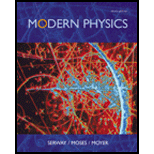
Modern Physics
3rd Edition
ISBN: 9781111794378
Author: Raymond A. Serway, Clement J. Moses, Curt A. Moyer
Publisher: Cengage Learning
expand_more
expand_more
format_list_bulleted
Concept explainers
Question
Chapter 14, Problem 16P
(a)
To determine
The cross sectional area of the sphere.
(b)
To determine
The cross section area of the sphere.
(c)
To determine
The intensity of the beam of light that emerges from the other end.
Expert Solution & Answer
Want to see the full answer?
Check out a sample textbook solution
Students have asked these similar questions
Concept Simulation 26.4 provides the option of exploring the ray diagram that applies to this
problem. The distance between an object and its image formed by a diverging lens is 5.90 cm.
The focal length of the lens is -2.60 cm. Find (a) the image distance and (b) the object distance.
Pls help ASAP
Pls help ASAP
Chapter 14 Solutions
Modern Physics
Ch. 14 - Prob. 1QCh. 14 - Prob. 2QCh. 14 - Prob. 3QCh. 14 - Prob. 4QCh. 14 - Prob. 5QCh. 14 - Prob. 7QCh. 14 - Prob. 8QCh. 14 - Prob. 9QCh. 14 - Prob. 10QCh. 14 - Prob. 11Q
Ch. 14 - Prob. 12QCh. 14 - Prob. 14QCh. 14 - Prob. 15QCh. 14 - Prob. 1PCh. 14 - Prob. 2PCh. 14 - Prob. 3PCh. 14 - Prob. 4PCh. 14 - Prob. 5PCh. 14 - Prob. 6PCh. 14 - Prob. 7PCh. 14 - Prob. 8PCh. 14 - Prob. 9PCh. 14 - Prob. 10PCh. 14 - Prob. 11PCh. 14 - Prob. 12PCh. 14 - The atomic weight of cadmium is 112.41, and its...Ch. 14 - Prob. 15PCh. 14 - Prob. 16PCh. 14 - Prob. 17PCh. 14 - Prob. 19PCh. 14 - Prob. 20PCh. 14 - Prob. 21PCh. 14 - Prob. 22PCh. 14 - Prob. 23PCh. 14 - Prob. 24PCh. 14 - Prob. 25PCh. 14 - Prob. 27PCh. 14 - Prob. 28PCh. 14 - Prob. 29PCh. 14 - Prob. 30PCh. 14 - Prob. 31PCh. 14 - Prob. 32PCh. 14 - Prob. 33PCh. 14 - Prob. 34PCh. 14 - Prob. 35PCh. 14 - Prob. 36PCh. 14 - Prob. 37PCh. 14 - Prob. 38PCh. 14 - Prob. 39PCh. 14 - Prob. 40PCh. 14 - Prob. 41PCh. 14 - Prob. 42PCh. 14 - Prob. 43PCh. 14 - Prob. 45PCh. 14 - Prob. 46PCh. 14 - Prob. 47PCh. 14 - Prob. 48PCh. 14 - Prob. 49PCh. 14 - Prob. 50PCh. 14 - Prob. 51PCh. 14 - Prob. 52PCh. 14 - Prob. 53PCh. 14 - Prob. 54PCh. 14 - Prob. 55PCh. 14 - Prob. 56PCh. 14 - Prob. 57PCh. 14 - Prob. 58PCh. 14 - Prob. 59PCh. 14 - Prob. 60P
Knowledge Booster
Learn more about
Need a deep-dive on the concept behind this application? Look no further. Learn more about this topic, physics and related others by exploring similar questions and additional content below.Similar questions
arrow_back_ios
SEE MORE QUESTIONS
arrow_forward_ios
Recommended textbooks for you
 Modern PhysicsPhysicsISBN:9781111794378Author:Raymond A. Serway, Clement J. Moses, Curt A. MoyerPublisher:Cengage Learning
Modern PhysicsPhysicsISBN:9781111794378Author:Raymond A. Serway, Clement J. Moses, Curt A. MoyerPublisher:Cengage Learning University Physics Volume 3PhysicsISBN:9781938168185Author:William Moebs, Jeff SannyPublisher:OpenStax
University Physics Volume 3PhysicsISBN:9781938168185Author:William Moebs, Jeff SannyPublisher:OpenStax Classical Dynamics of Particles and SystemsPhysicsISBN:9780534408961Author:Stephen T. Thornton, Jerry B. MarionPublisher:Cengage Learning
Classical Dynamics of Particles and SystemsPhysicsISBN:9780534408961Author:Stephen T. Thornton, Jerry B. MarionPublisher:Cengage Learning College PhysicsPhysicsISBN:9781938168000Author:Paul Peter Urone, Roger HinrichsPublisher:OpenStax College
College PhysicsPhysicsISBN:9781938168000Author:Paul Peter Urone, Roger HinrichsPublisher:OpenStax College Principles of Physics: A Calculus-Based TextPhysicsISBN:9781133104261Author:Raymond A. Serway, John W. JewettPublisher:Cengage Learning
Principles of Physics: A Calculus-Based TextPhysicsISBN:9781133104261Author:Raymond A. Serway, John W. JewettPublisher:Cengage Learning Physics for Scientists and Engineers with Modern ...PhysicsISBN:9781337553292Author:Raymond A. Serway, John W. JewettPublisher:Cengage Learning
Physics for Scientists and Engineers with Modern ...PhysicsISBN:9781337553292Author:Raymond A. Serway, John W. JewettPublisher:Cengage Learning

Modern Physics
Physics
ISBN:9781111794378
Author:Raymond A. Serway, Clement J. Moses, Curt A. Moyer
Publisher:Cengage Learning

University Physics Volume 3
Physics
ISBN:9781938168185
Author:William Moebs, Jeff Sanny
Publisher:OpenStax

Classical Dynamics of Particles and Systems
Physics
ISBN:9780534408961
Author:Stephen T. Thornton, Jerry B. Marion
Publisher:Cengage Learning

College Physics
Physics
ISBN:9781938168000
Author:Paul Peter Urone, Roger Hinrichs
Publisher:OpenStax College

Principles of Physics: A Calculus-Based Text
Physics
ISBN:9781133104261
Author:Raymond A. Serway, John W. Jewett
Publisher:Cengage Learning

Physics for Scientists and Engineers with Modern ...
Physics
ISBN:9781337553292
Author:Raymond A. Serway, John W. Jewett
Publisher:Cengage Learning